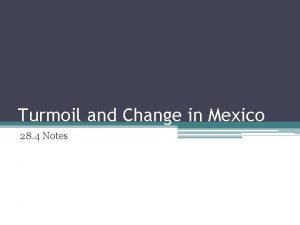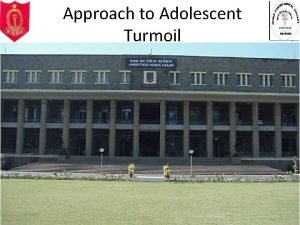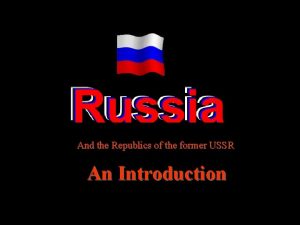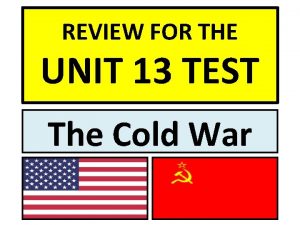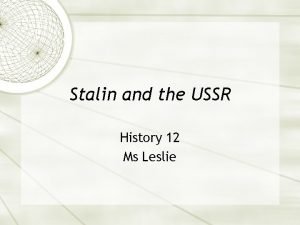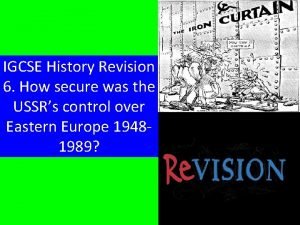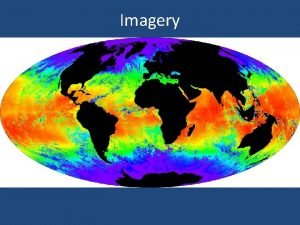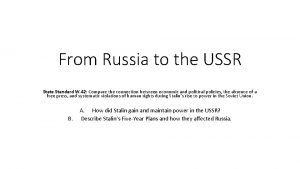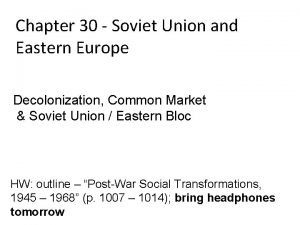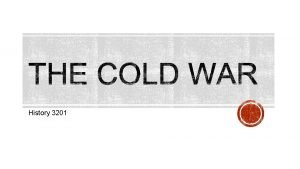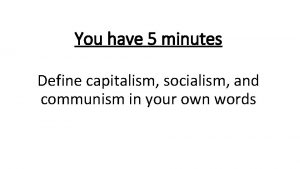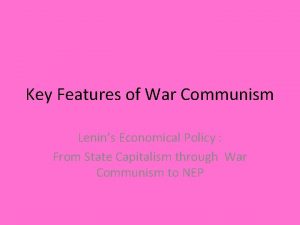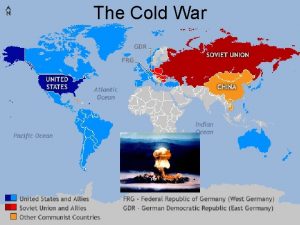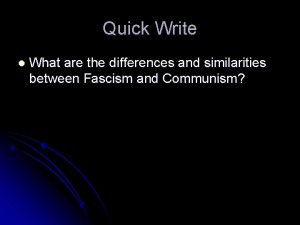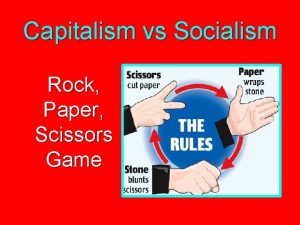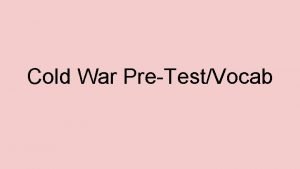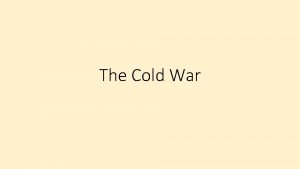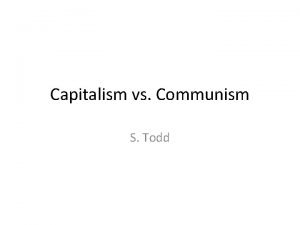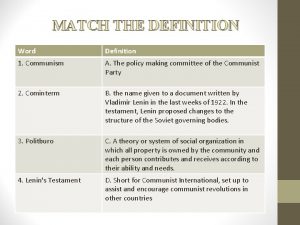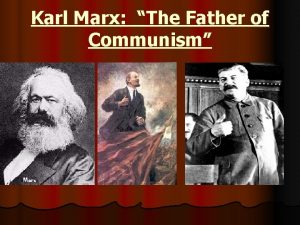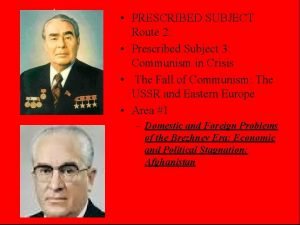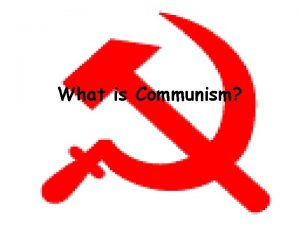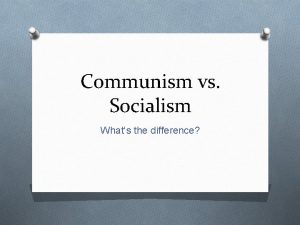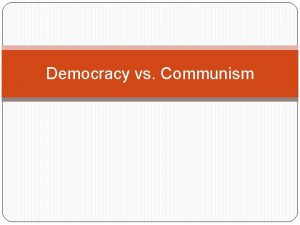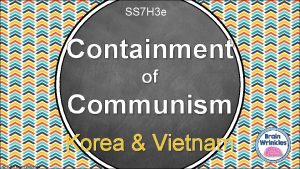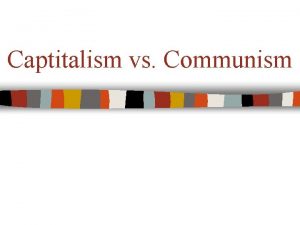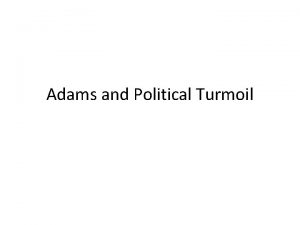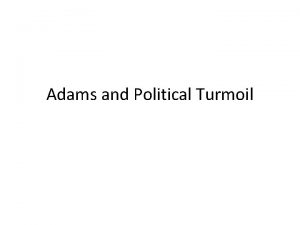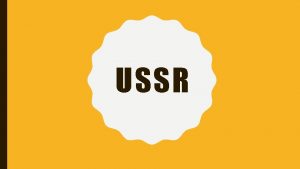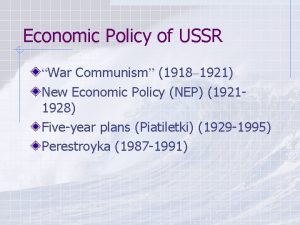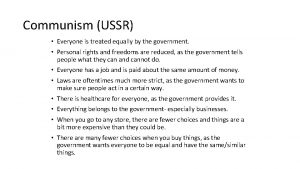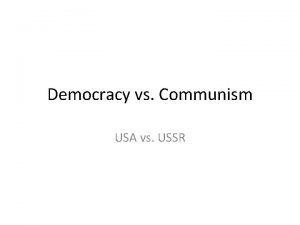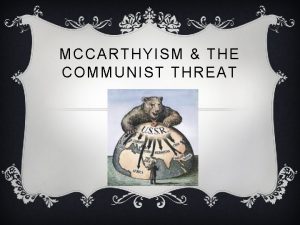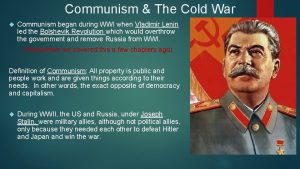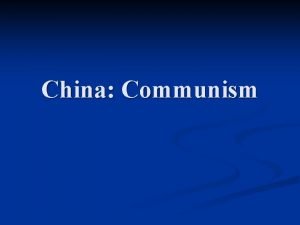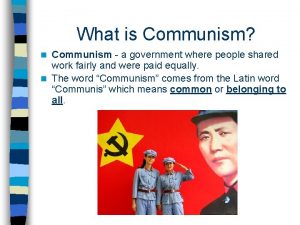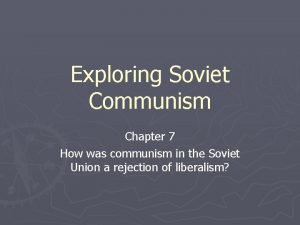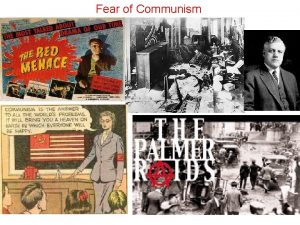The Fall of Communism Turmoil in the USSR






























- Slides: 30

The Fall of Communism

Turmoil in the USSR The USSR had over 100 ethnic groups living within. This created problems because the different nationalities began to call for freedom. The nationalities (being Non Russian) formed the majority in the other republics of the USSR

Turmoil in the USSR When Gorbachev put reforms in place, national groups in Georgia, the Ukraine and Moldova demanded self rule. Muslims in other areas of the USSR called for religious freedom. In March of 1990, Lithuania took things one step further by declaring independence from the USSR

Turmoil in the USSR Gorbachev did not like Lithuania’s declaration of independence and ordered an economic blockade of the country. He feared that Lithuania’s actions might encourage other republics to secede. Gorbachev sent troops into Lithuania where hundreds were killed and wounded.

August Coup There were members of the Communist Party which we call “hard liners” because they were Conservative Communists who opposed the reforms that Gorbachev put in place. They were furious that Gorbachev had given up the USSR’s role as the dominant force in Eastern Europe. They also feared losing their power and privileges and things changed in the country.

August Coup On August 18, 1991, Communist hardliners had Gorbachev detained at his vacation home and demanded that he resign from power. Tanks rolled into Moscow and surrounded government offices. However, Soviet citizens were now willing to fight to defend the freedoms they were given and began to protest.

August Coup Boris Yeltsin (the president of the Russian republic) became a significant figure during the August Coup and he joined with the protestors. The hardliners had ordered troops to attack the protestors, but the military refused. The military withdrew from Moscow and Gorbachev returned.

The August Coup Watch this video for footage

Rule of Boris Yeltsin As president of the Russian federation, Boris Yeltsin had to deal with an ailing economy, tough political opposition and an unpopular with Chechnya.

Rule of Boris Yeltsin To deal with Russia’s failing economy, Yeltsin used Shock Therapy - an abrupt shift to free market economics. As part of Shock Therapy, he lowered trade barriers, removed price controls and ended subsidies. As a result of Shock Therapy, prices soared, inflation went to about 800%, and factories either cut production or closed down

Rule of Boris Yeltsin In October of 1993, Russian legislators who opposed Yelstin’s policies, shut themselves inside the Parliament building. When Yelsin ordered troops to bombard the building, many of those legislators surrendered but many were also killed. Yeltsin was accused of acting like a dictator.

Rule of Boris Yeltsin Chechnya is a largely Muslim area in the Southwestern part of Russia. They had wanted their independence, but Yeltsin denied their right to secede. He sent 40, 000 troops in Chechnya. They signed a cease fire agreement in 1996, but war started back up again after Yeltsin’s reelection.

Poland Events that led to the fall of communist regime” a failing economy it was under military rule Notable People/groups Lech Walesa Solidarity Alexander Kwasniewski

Poland Changes made under the new government: Shock Therapy Free market economy joined NATO Allies with the United States

Poland Watch this video:

Hungary Events that led to the fall of communist regime: Inspired by Poland Radicals took over Communist Party dissolved Notable People/Groups Socialist Democratic Party

Hungary Changes made under government: Encouraged private business and stock market multi party free elections joined NATO

East Germany Events that led to fall of communist regime: Closed its borders and riots broke out Berlin Wall came down United with West Germany 10/3/90 Notable People/Groups Egon Krenz (East Germany) Helmut Kohl (West Germany

East Germany Changes made under government: ½ of the country was underdeveloped (former East German side) raised taxes to fund improvements increasingly growing economy

East Germany The Fall of the Berlin Wall

Czechoslovakia Events that led to fall of communist regime: inspired by East German freedom protests began to occur government used violence against protestors Czech leader, Milos Jakes, resists change Notable People/Groups Vaclav Havel

Czechoslovakia Changes made under government: began using Shock Therapy split into 2 countries on 1/1/93 Czech Republic joined both NATO and the European Union Slovakia experiences growth

Czechoslovakia The Velvet Revolution

Romania Events that led to fall of communist regime: Timisoara Massacre ignited an uprising army joined with the people executed the old leaders (Ceaucescu) Notable People/Groups Ion Iliescu

Romania Changes made under government: Crime and corruption slow progress toward capitalism

Fall of Communism in Eastern Europe

Yugoslavia Events that led to fall of communist regime: Tito dies Ethnic resentment boiled over Milosevic took over Slovenia and Croatia declared indepdence

Yugoslavia Notable People/Groups Slobadan Milosevik uses violence and ethnic cleansing on Muslims in Bosnia

Yugoslavia

Yugoslavia Changes made under government: elected 3 person presidency 1 president from each ethnic group Kosovo declared independence struggle toward democracy and free market economy
 Turmoil and change in mexico
Turmoil and change in mexico Chapter 28 section 4 turmoil and change in mexico
Chapter 28 section 4 turmoil and change in mexico Adolescent turmoil definition
Adolescent turmoil definition Ussr
Ussr Ussr
Ussr Ussr first satellite
Ussr first satellite Usa ussr
Usa ussr Igcse history chapter 6
Igcse history chapter 6 Ussr first satellite
Ussr first satellite How did stalin gain and maintain power in the ussr?
How did stalin gain and maintain power in the ussr? Arms race
Arms race Containment soviet union
Containment soviet union Communism and capitalism dbq answer key
Communism and capitalism dbq answer key Designed by
Designed by Disadvantages of communism
Disadvantages of communism Marshall plan communism
Marshall plan communism Starburst graphic organizer
Starburst graphic organizer Socialism vs communism
Socialism vs communism Describe the similarities between fascism and communism
Describe the similarities between fascism and communism Capitalism socialism communism rock paper scissors
Capitalism socialism communism rock paper scissors Pretest communism and the cold war
Pretest communism and the cold war Was the cold war capitalism vs communism
Was the cold war capitalism vs communism Communism is better than capitalism pros and cons
Communism is better than capitalism pros and cons Match the following terms with their definitions communism
Match the following terms with their definitions communism What is socialism?
What is socialism? Trotskyism vs communism
Trotskyism vs communism Communism
Communism Communism meaning simple
Communism meaning simple Whats socialism vs communism
Whats socialism vs communism Democracy vs communism political cartoon
Democracy vs communism political cartoon Containment of communism cloze notes
Containment of communism cloze notes

